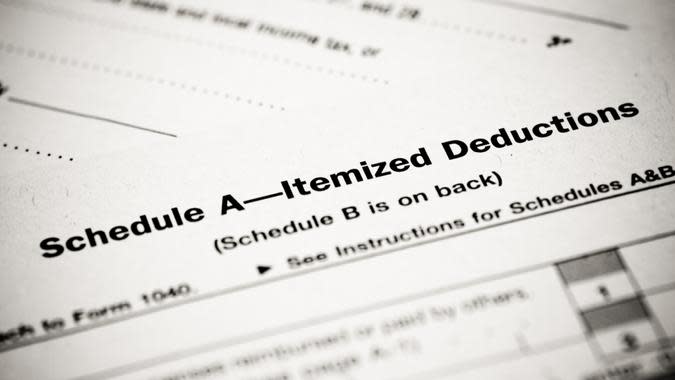10 Tax Breaks Every Filer Should Know About

Tax season is here and it's time to file your tax return for 2023. The end of January should have marked the beginning of your W2s and 1099s being sent by mail or digitally, which means you can start to compile your expenses and gather your tax write-offs to offset your income.
Write Off Your Mileage? The IRS Expands the Deduction for Fuel Costs in 2023
Read: If Your Credit Score Is Under 600, Make These 3 Moves ASAP
In addition to the more obvious tax deductions, such as IRA contributions, plenty of lesser-known or underused tax breaks can help you lower your tax bill. Here are just a few.

Cash Contributions to Charity
If you write a check or make a credit card donation to a charity, you'll normally get a written receipt so you can deduct it on your taxes. But, if you make cash contributions, you might not always get a receipt, and you might not remember your donation at tax time. But those contributions are still tax-deductible if you itemize deductions. Always do what you can to get a receipt even if you make a small or a cash contribution to a charity because, no matter the size, those donations are legally tax-deductible.
Live Richer Podcast: Why Not Having a High-Yield Savings Account Can Be a Huge Mistake

Moving Expenses for Military
Unfortunately for many taxpayers, the deduction for moving expenses was eliminated in 2018. However, it still remains in place for a select group of taxpayers -- specifically, members of the Armed Forces. To qualify for the deduction, you must be on active duty and ordered by the military to move yourself, your spouse or your dependents due to a permanent change of station. Allowable expenses include the costs of moving goods and personal effects, including crating, packing, hauling and storing costs.

Stimulus Payments
Most Americans received a series of stimulus payments via direct deposit. If you never received them and were eligible, you needed to claim them when you filed your 2020 and/or 2021 tax return(s). That's because the stimulus payments were actually advance payments of a recovery rebate tax credit. As a tax credit, the payments act as a dollar-for-dollar reduction of any tax liability you may have. If you're due more than you owe, the rest will come in the form of a tax refund. So if you're eligible but haven't filed returns for those years, you'll need to do so to collect your credit -- even if you don't normally file a tax return. If you've already filed but didn't claim the credit you were entitled to, you can file an amended return using Form 1040-X.

EITC
The Earned Income Tax Credit is one of the most popular tax credits Americans use -- but, according to the IRS, more than 20% of eligible taxpayers don't claim the credit. The EITC is a refundable credit payable to low- and moderate-income taxpayers with qualifying children, although some households can qualify without children as well. As a credit, it can be paid in the form of a refund if it exceeds the amount of your tax liability. For the tax year 2023, credits can reach as high as $7,430 for qualifying households with at least three children.

Saver's Credit
Most Americans understand that they may be entitled to a tax deduction if they make a contribution to an IRA or other retirement account. However, what many overlook is the Retirement Savings Contributions Credit, also known as the Saver's Credit.
Depending on your adjusted gross income, you may qualify for a tax credit of up to 50% of the amount you contribute to a qualifying retirement plan. The minimum available credit is 10% of the amount of your contribution.
For the tax year 2023, joint filers can qualify for the full 50% credit with an AGI of up to $43,500. The credit is 20% for an AGI of $43,501 to $47,500 and 10% for up to $73,000. The credit is based on a maximum contribution of $2,000 for singles or $4,000 for joint filers.

State and Local Taxes
When taxpayers itemize deductions, they can choose to deduct either state and local income taxes or state and local sales taxes. This provides a benefit for taxpayers living in states without an income tax, as they can choose to deduct their sales taxes instead. However, depending on your state tax rates, income level and other factors, even if you're in a state that assesses income taxes, you might be better off deducting your sales taxes instead.

Housing Expenses
Mortgage interest is a well-known tax deduction, but many Americans are unaware that there are additional housing expenses that qualify for a tax write-off. If you pay points to get your mortgage interest rate lowered, for example, you can deduct that expense on your taxes. Similarly, the annual property tax you pay is also a qualifying tax deduction. Just remember that these types of deductions are itemized, meaning they'll have to exceed the standard deduction before they're worthwhile for you to take.

Personal Property Taxes
If you get frustrated every year you have to pay registration taxes for your car, RV or boat, there's at least some relief at tax time. You can generally deduct the personal property tax amount of your registration on these types of vehicles. Just bear in mind that you can't usually deduct the full amount that you pay for your registration, only the personal property tax amount.

Large Medical Expenses
The deduction for medical expenses doesn't kick in unless you have some significant bills, so many Americans simply overlook this deduction. But you can take a tax deduction for substantial medical bills that exceed 7.5% of your adjusted gross income and aren't covered or reimbursed by any other source.

Child and Dependent Care Credit
The Child and Dependent Care Credit is commonly used, but it underwent some major changes for tax year 2021. Those enhancements have expired, so the regular rules are in effect for tax year 2023. The nonrefundable credit is worth 20% to 35% of qualifying childcare expenses, depending on your AGI, with a limit of $2,100 for one child or dependent.
More From GOBankingRates
This article originally appeared on GOBankingRates.com: 10 Tax Breaks Every Filer Should Know About

 Yahoo Movies
Yahoo Movies 